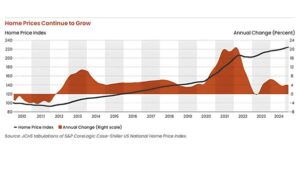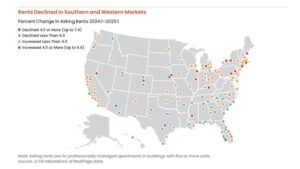The 1% Rule in Real Estate: Does It Still Work in 2025?

In the world of rental properties, the 1% rule in real estate has long been a familiar guideline. The simple investing rule has been a go-to for decades, helping landlords quickly screen properties to see if they might generate enough income to cover expenses and deliver a profit.
But with the volatile real estate market of 2025, is the 1% rule still effective? Let’s break it down in this article.
What Is the 1% Rule in Real Estate?
The 1% real estate rule is an instant check for a rental property’s potential. What that means is, with the 1 rule, which basically states your rental income per month has to be at least equal to 1% of what you paid for the property.
For example, if you pay $300,000 for a home, the rent should be at least $3,000 a month. This principle acts as an initial filter, allowing you to dismiss properties that are unlikely to be profitable quickly.

For many landlords, the 1% rule in real estate is a fast way to decide whether a property deserves a closer look. Beyond the initial filter, the rule:
- Acts as a trusted guideline for rental property investments.
- Helps landlords very quickly see if the rent will cover the mortgage and support positive cash flow.
- Useful at the start of the property evaluation process before into in depth analysis.
When applied in the right market conditions, the approach can deliver reliable results and guide landlords toward properties with stronger investment potential.
The 1% investing rule works well for single-family homes and smaller multifamily units in markets where home prices and rents are balanced. It’s also handy for new investors who want a rental litmus test before spending time and money on inspections and appraisals.
Formula to Calculate
Now that you’ve understood what the 1% rule is for rental property, the 1% rule real estate calculator is straightforward:
| Purchase Price / Monthly Rent ≥ 1% rule ratio |
If the result is 1% or higher, the property passes the test.
For example:
You are searching for a new townhouse that costs $450,000. After successful price negotiations you acquired the property for $420,000. Your research indicates that comparable townhouses in the area can be rented for $4,500 per month.
The evaluation of this property requires the application of the 1% rule using these two pieces of information.
| $4,500 (monthly rent)/ $420,000 (purchase price) = 1.07% |
The townhouse satisfies the 1% rule in real estate because its gross monthly rental income ($4,500) exceeds 1% of the purchase price. The property shows promise as an investment opportunity because it meets the 1% rule criteria.
Other Rules You May Hear About
While the 1% rule is popular, it’s not the only benchmark in the rental market. For example:
- The 2% rule in real estate: Similar to the 1% rule, this is a more aggressive approach where rent should be 2% of the purchase price. It’s rare in today’s market except in very low-cost areas.
- 4-3-2-1 rule real estate: This is a zoning and land-use rule of thumb that refers to the percentage of land value allocated to different uses: 4 for the mortgage, 3 for industrial, 2 for commercial, and 1 for unused or other purposes.
Each rule offers a different lens for evaluating rent investment potential, but none should be the sole factor in your decision.
Why the 1% Rule Is Harder to Use in 2025
The 2025 real estate market has changed significantly. This makes applying the 1 rule real estate calculator more complex.
High Home Prices, Slower Rent Growth

According to Harvard JCHS’s The State of the Nation’s Housing 2025 report, the median home price in the U.S. has risen by about 60% since 2019, while rent growth has lagged far behind.
The rental income to mortgage ratio for many investors is being affected. Rents are not increasing fast enough to meet the 1% rule. Therefore, it’s getting harder than ever to find properties that meet the 1% rule benchmark
The Rule Doesn’t Fit All Property Types or Markets

The 1% rule may not be suitable for all types of properties. For example, it might work for suburban homes, but it’s not accurate in specific markets.
- Coastal cities or high-demand zones: In these areas, property prices are very high, but rents cannot increase proportionally.
- Commercial rental property for rent: Commercial properties often have different financial characteristics than residential ones. Thus, applying the 1% rule can lead to misleading results.
Let’s consider two different markets: San Francisco, a coastal city with extremely high home prices, and Cleveland, a city in the Midwest with more affordable housing.
San Francisco is a high-demand coastal market
A typical home in San Francisco might cost up to $1,200,000. To follow the 1% rule, the monthly rent would need to be $12,000. However, the average rent for a similar home in this area is only around $5,000. Clearly, this investment would not meet the 1% rule and wouldn’t generate positive cash flow based on this principle.
Meanwhile, Cleveland leans toward being an affordable market in the Midwest.
In Cleveland, a similar single-family home might only cost $150,000. According to the 1% rule, you would need to rent it for $1,500 per month. With an average rent of $1,600 in the area, this home not only meets but exceeds the threshold of the 1% rule real estate calculator.
When (and When Not) to Use the 1% Rule in 2025
The 1% rule still works as a rental litmus test in mid-tier markets where purchase prices and rents are balanced. It’s especially helpful for landlords managing multiple properties who need a quick filter before deeper analysis. For example, a Fort Worth investor in 2025 uses this rule to ensure each new building rents at least 1% of its cost, yielding about $330 per month per unit and around $40,000 in annual passive income.
When the 1% rule still works:
- Markets like Fort Worth, Texas—where construction justifies rental income—allow landlords to quickly filter out unprofitable properties.
- It’s a quick way to evaluate multiple investment opportunities before deeper analysis.
However, in expensive metros, sticking to this rule might make you overlook properties that, while below 1%, could still generate strong returns through appreciation or tax benefits.
When It’s Still Helpful
The 1% rule in real estate is still a good starting point for screening:
- Helps landlords quickly screen single-family homes in suburban or rural areas.
- Using the 1% rule in real estate for investing in private equity
- Assessing small multifamily units in balanced markets.
- Comparing similar properties in the same neighborhood.
When You Need More Than Just a Rule
The 1% rule is a great starting point, but it’s not the full picture. A property that fails to meet the benchmark may still provide strong returns if it demonstrates other positive characteristics, such as a vacancy rate under 3% and annual appreciation between 5-7% and a location with persistent rental demand. Excluding this investment due to its failure to reach 1% could result in missing out on potentially profitable returns.
The rule fails to consider essential elements, which include maintenance expenses together with property taxes and insurance premiums, and mortgage interest rates.
Tips to Protect Your Investment After the 1% Rule

Even if a property seems to meet the 1% rule, you still need to take solid steps to protect your investment.
Tenant Screening Matters
One of the most important factors for a rental property is the tenant. Using reliable tenant background screening services and knowing the legal process for handling problem tenants, including their credit history and past evictions, is an essential step.
Use the 3x Rent Rule to Reduce Risk
A common safeguard is to require tenants to have a monthly income of at least 3 times the rent. This reduces the chance of late payments or defaults.
Bottom Line
The 1% rule for rental property remains a useful starting point for landlords, but it’s not the end-all solution. In 2025’s market, you’ll need to combine it with other evaluation tools, consider market trends, and use strong tenant screening to protect your rent investment.
Profitable rental decisions can still be guided by it when applied properly, but keep in mind that rules are only recommendations.


